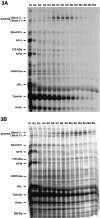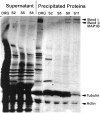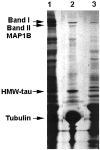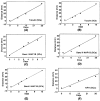Axonal transport of microtubule-associated protein 1B (MAP1B) in the sciatic nerve of adult rat: distinct transport rates of different isoforms
- PMID: 10704485
- PMCID: PMC6772501
- DOI: 10.1523/JNEUROSCI.20-06-02112.2000
Axonal transport of microtubule-associated protein 1B (MAP1B) in the sciatic nerve of adult rat: distinct transport rates of different isoforms
Abstract
Cytoskeletal proteins are axonally transported with slow components a and b (SCa and SCb). In peripheral nerves, the transport velocity of SCa, which includes neurofilaments and tubulin, is 1-2 mm/d, whereas SCb, which includes actin, tubulin, and numerous soluble proteins, moves as a heterogeneous wave at 2-4 mm/d. We have shown that two isoforms of microtubule-associated protein 1B (MAP1B), which can be separated on SDS polyacrylamide gels on the basis of differences in their phosphorylation states (band I and band II), were transported at two different rates. All of band I MAP1B moved as a coherent wave at a velocity of 7-9 mm/d, distinct from slow axonal transport components SCa and SCb. Several other proteins were detected within the component that moved at the velocity of 7-9 mm/d, including the leading wave of tubulin and actin. The properties of this component define a distinct fraction of the slow axonal transport that we suggest to term slow component c (SCc). The relatively fast transport of the phosphorylated MAP1B isoform at 7-9 mm/d may account for the high concentration of phosphorylated MAP1B in the distal end of growing axons. In contrast to band I MAP1B, the transport profile of band II was complex and contained components moving with SCa and SCb and a leading edge at SCc. Thus, MAP1B isoforms in different phosphorylation states move with distinct components of slow axonal transport, possibly because of differences in their abilities to associate with other proteins.
Figures








Similar articles
-
Differential axonal transport of isotubulins in the motor axons of the rat sciatic nerve.J Cell Biol. 1989 Mar;108(3):965-71. doi: 10.1083/jcb.108.3.965. J Cell Biol. 1989. PMID: 2921287 Free PMC article.
-
Alterations in slow transport kinetics induced by estramustine phosphate, an agent binding to microtubule-associated proteins.J Neurosci Res. 1992 Aug;32(4):481-93. doi: 10.1002/jnr.490320404. J Neurosci Res. 1992. PMID: 1382136
-
Hypothyroidism reduces the rate of slow component A (SCa) axonal transport and the amount of transported tubulin in the hyt/hyt mouse optic nerve.J Neurosci Res. 1991 Jan;28(1):121-33. doi: 10.1002/jnr.490280113. J Neurosci Res. 1991. PMID: 1710281
-
Organization and slow axonal transport of cytoskeletal proteins under normal and regenerating conditions.Mol Neurobiol. 1992 Summer-Fall;6(2-3):301-11. doi: 10.1007/BF02780559. Mol Neurobiol. 1992. PMID: 1282336 Review.
-
Retardation in the slow axonal transport of cytoskeletal elements during maturation and aging.Neurobiol Aging. 1989 Jul-Aug;10(4):359-65. doi: 10.1016/0197-4580(89)90049-3. Neurobiol Aging. 1989. PMID: 2478905 Review.
Cited by
-
The slow axonal transport of alpha-synuclein--mechanistic commonalities amongst diverse cytosolic cargoes.Cytoskeleton (Hoboken). 2012 Jul;69(7):506-13. doi: 10.1002/cm.21019. Epub 2012 Mar 2. Cytoskeleton (Hoboken). 2012. PMID: 22344896 Free PMC article.
-
Tau phosphorylation affects its axonal transport and degradation.Neurobiol Aging. 2013 Sep;34(9):2146-57. doi: 10.1016/j.neurobiolaging.2013.03.015. Epub 2013 Apr 17. Neurobiol Aging. 2013. PMID: 23601672 Free PMC article.
-
Seeing the unseen: the hidden world of slow axonal transport.Neuroscientist. 2014 Feb;20(1):71-81. doi: 10.1177/1073858413498306. Epub 2013 Aug 2. Neuroscientist. 2014. PMID: 23912032 Free PMC article. Review.
-
Cholinergic activity is essential for maintaining the anterograde transport of Choline Acetyltransferase in Drosophila.Sci Rep. 2018 May 23;8(1):8028. doi: 10.1038/s41598-018-26176-z. Sci Rep. 2018. PMID: 29795337 Free PMC article.
-
The TRIM9/TRIM67 neuronal interactome reveals novel activators of morphogenesis.Mol Biol Cell. 2021 Feb 15;32(4):314-330. doi: 10.1091/mbc.E20-10-0622. Epub 2020 Dec 30. Mol Biol Cell. 2021. PMID: 33378226 Free PMC article.
References
-
- Baas PW, Yu W. A composite model for establishing the microtubule arrays of the neuron. Mol Neurobiol. 1996;12:145–161. - PubMed
-
- Bamburg JR, Bray D, Chapman K. Assembly of microtubules at the tip of growing axons. Nature. 1986;321:788–790. - PubMed
-
- Black MM, Lasek RJ. A difference between the proteins conveyed in the fast component of axonal transport in guinea pig hypoglossal and vagus motor neurons. J Neurobiol. 1978;9:433–443. - PubMed
-
- Black MM, Lasek RJ. Axonal transport of actin: slow component b is the principal source of actin for the axon. Brain Res. 1979;171:401–413. - PubMed
Publication types
MeSH terms
Substances
Grants and funding
LinkOut - more resources
Full Text Sources
Research Materials
